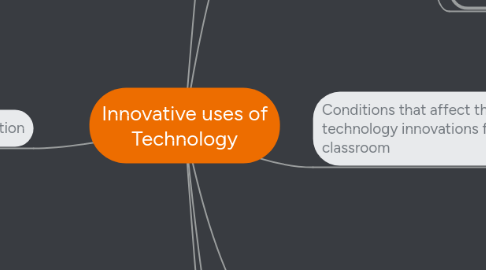
1. Defintion
1.1. Adapting and using the technology that is available to improve teaching and learning in the classroom and online.
2. Affect on Teaching and Learning
2.1. Increased demand on staff.
2.1.1. Teachers are required to put in more work to create online learning opportunities
2.2. May force quality teachers to change their approach even if it is not research sound.
2.2.1. Example: Technology offers many promises and the temptation can be for a district to push technology on their staff even if it is not best for the students. Recently students within my district received iPads and the thought was that students would get smater simply by having the device. This has not been the case. The conditions for success are not in place.
2.3. Conditions must be considered.
2.3.1. If done properly can lead to above advantages.
2.3.2. If conditions are not properly considered the limitations of technology use will be experienced.
3. Variation from Tradition
3.1. Delivery of instruction is dependent upon more people than just the teacher.
3.1.1. Example: Schools now have technology departments that are responsible for updating computer and software.
3.1.2. Example: If a school does not have a 1:1 computer to student ratio computer lab time is dependent upon availability that results from other teachers' use.
3.2. Varies approaches to how students can absorb content and then demonstrate mastery of that content.
3.2.1. Technology can increase the variation in teaching, the days of direct instruction is a thing of the past.
3.2.1.1. Examples include, but are not limited to, glogs, blogs, digital stories, videos, digatial collages, screencasts, concept maps, etc.
4. Advantages
4.1. Has the ability to lead students to dynamic thinking.
4.1.1. Example: Using Prezi or MindMeister to have students create digital concept maps. This provides the student with the opportunity to go deeper with their understanding.
4.2. Can help a student overcome a lack of necessary prior knowledge to still achieve outcomes of the course.
4.2.1. Example: Students who struggle with spelling can use a word processor.
4.2.2. Example: Students in math can use a calculator or a computer program to allow them to demonstrate mastery of advanced concepts despite a lack of proficientcy in basic arithmetic.
4.3. Can better inform teacher and student as to what a student does and does not know.
4.3.1. Example: Applications such as Socrative allow teachers to gain instant feedback from students.
4.3.2. Assessment software can provide both student and teacher with real-time data pertaining to student knowledge.
4.4. Can give students access to resources and material that are normally not afford.
4.4.1. Example: With the popularity of screencasting a student can learn what ever they want and when ever they want. A great example of this is Khan Academy.
5. Limitations
5.1. Lack of funding can keep districts from properly deploying technology
5.1.1. Many of the resources needed for technology to be seamlessly integrated into the classroom are dependent upon funding.
5.2. Can give a district a skewed understanding about learning.
5.2.1. A popular credit recovery class called E20/20 proves to be much more difficult than what a district believes it should be.
5.2.1.1. Technology is not a substitute for a teacher but rather a tool.
5.3. Can not be effectively implemented without thoughtful planning and communication by an entire district.
6. Maintainence
6.1. Technology needs to be maintained. Subscriptions to websites renewed, hardware improvements made, software updates made.
6.2. Teachers need to be maintained
6.2.1. Professional development has to address specific uses of technology and provide the appropriate training for its use in the classroom.
